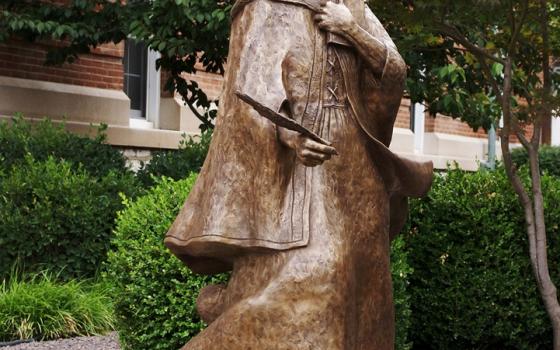"Difficult Dialogues" — that was the theme of the 2009 National Women's Studies Association in Atlanta. I was invited to be a panelist at this meeting focused on gender issues. My presentation explored the strategies developed by our founder, Blessed Theresa Gerhardinger, in relating to Archbishop Reisach of Munich, president of the German bishops council in 1850.
As in the history of many congregations, this one-time friend and mentor gradually changed to a controlling influence as the congregation grew in reputation and numbers. In a difficult dialogue over approval of the Rule, our foundress was placed under "interdict," which meant she was not allowed to accept new members or found new missions. It was a dark night for her and the young congregation to follow Christ in non-violent resistance. This was challenging: She essentially asked the Vatican to allow a woman to lead the congregation with no male director over her.
Later, the term "agency of women" would be coined in feminist scholarship, to refer to the belief that a woman could trust her own insights, inner authority, and worldview regardless of male approval. Long before the women's movement, this agency was exemplified by women religious who risked all to follow their inner truth.
As many women know, this claiming of adulthood in a male-dominated society and church sets the stage for "difficult dialogues."
It was thanks to Prof. Margaret Susan Thompson (associate professor of history and political science, the Maxwell School of Citizenship and Public Affairs at Syracuse University) that I was invited to participate on her panel. The experience taught me how much women have to share with one another about living in a patriarchal society. I listened to keynoters addressing more than a thousand women from around the world and reflected that women religious have experiences to add to this vital conversation.
Later I carefully studied the events of 1852-1865 and recognized several different strategies that our sisters exercised with Blessed Theresa's encouragement and leadership. Some of them will sound familiar to current-day women religious!
They sent letters to bishops of dioceses where our sisters were serving, asking them to share their experience of the sisters, enlisting the support of other members of the hierarchy who were closer to the action of the sisters at the grassroots level. By supporting Mother Theresa, these priests/bishops were standing with a new foundress rather than with their archbishop.
They also enlisted the help of a friend, a Rome-educated priest, to be their spokesperson. We know that in order to get things done in Rome, you have to know the political scene and speak the "language" of the Roman church. In a painfully candid letter to him, Mother Theresa shared her feelings honestly — how could anyone have resisted her?
She writes from her heart:
I also wanted to tell you about the future direction of our order according to the archbishop's basic plan but I will only add one thing now. God called us poor School Sisters into being so that girls and young women would be taught and trained by women and not by men. How would it be, what benefit would it bring, if these same women must be trained, educated and directed by men, and become completely dependent on them like tendrils on a vine, unable to do anything without their knowledge and forced to tell them everything, even the least little things? How does this fit together?
Another helpful strategy I found in our history was an attempt to be sure all sisters were on board. The General Council sent copies of both Archbishop Reisach's Rule and Mother Theresa's Rule, asking each professed sister which rule she preferred. And throughout the process, Mother Theresa relied on the counsel and support of her sisters.
She did communicate directly with the Holy Father — women know how important that first-person connection is! She told him that she had asked each sister and gave him their responses, as well as the responses of influential members of their local civic and religious communities. Get the laity on board! United States sisters will remember what happened during the apostolic visitation and the doctrinal assessment. …
She also offered him some possible solutions (always better to offer ones you thought of yourselves than rely on chance that you'll be handed less desirable ones), even offering to resign herself.
Mother Theresa and her sisters did not lose hope — too often overlooked as a "strategy." As sisters did in the doctrinal assessment of the Leadership Conference of Women Religious (LCWR), they made the mission of Jesus their priority and were dedicated to their ministry even as they were being investigated by the Vatican. They took courage from their prayer, convictions, and even in the following dream.
Mother Theresa reports:
Now we must tell you about a dream our good Sister Petra [Foreria Schießer] had. She saw the archbishop in the form of a wolf lying at the altar of the convent church in Amberg, but it was constantly rearing up against us. To the right of the altar, Mary was standing with her Divine Child and striking the wolf with her Son's cross until it could no longer get up.
Of their challenging meeting with the archbishop, we read the crushing experience that this "difficult dialogue" was for Mother Theresa. A one-act play based on minutes of this meeting shows the emotional content couched in polite persistence on the phrase, "according to our former observances." Sounding almost like they had been coached by a lawyer, the sisters responded to the archbishop using the same phrase. This indicated their steadfast loyalty to remain under the direction of a female superior, Mother Theresa. When the Archbishop leaves in anger, the sisters are left in a "dark night" distress, which almost crushed our foundress. It was their creative strategies that saved the congregation and offered a new form of religious leadership.
And as for "the rest of the story:" Mother Theresa and the archbishop were eventually reconciled, and the community cemented their understanding with Rome by asking for the appointment of a Cardinal Protector, which was done. Another sister was sent to Rome where she continued the work of building a relationship with Vatican officials and sharing gifts handmade by the sisters (the personal touch, very womanly!).
Mother Theresa's Beatification in 1985 was seen as a sign of her fidelity as well as her induction into the Bavarian Hall of Fame.
Other religious congregations can affirm these strategies; our response has always been to be "Wise as serpents, gentle as doves," both in dedication (some call it stubbornness) and in creativity. There is a deep well of potential within women, and this includes women religious.
In my research there is an unsolved mystery for me: How was all of this financed, knowing we barely had enough income for necessities?
From participating in the women's studies conference years ago, I was aware of how my "sisters" in academia might view our experience with the Vatican. One analysis of our recent apostolic visitation is provided by Thompson in "Circles of Sisterhood: Formal and Informal Collaboration among American Nuns in Response to Conflict with Vatican Kyriarchy" published in the Journal of Feminist Studies in Religion, fall 2016.
[Judith Best is a School Sister of Notre Dame and coordinator of SturdyRoots.org. She gives presentations on the heritage of the School Sisters of Notre Dame and is also exploring evolution as the bridge between science and religion.]

